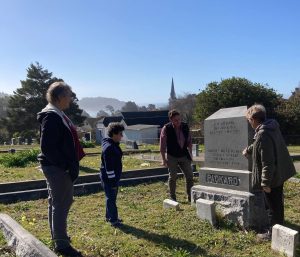There are people who don’t like to wander through cemeteries, perhaps because they want to avoid remembering that we are dust, and to dust we shall return. But for some of us, an hour or two in an old cemetery is like a magical turn in Mr. Peabody’s Wayback Machine. If you belong in the latter category, the new Kelley House tour of Evergreen Cemetery is for you. It’s possible to learn as much about the important people and events in Mendocino’s history in this stroll through the city of the dead as it is from a walk through the town’s lively streets.

A tour group learns about C.O. Packard, a carpenter turned successful town druggist.
At their graves, the tour leader profiles some of Mendocino’s founding fathers: Jerome Ford, David Lansing, and the Heesers—William and Auggie. Some of its mothers are buried here too and their lives are no less fascinating. Alice Grindle, Hattie Blair, Charlotte Hoak, and Cinderella Rueckert (actually more like an eccentric aunt than a mother) are waiting patiently to share their life stories.
When the three-acre cemetery was established in 1864, it was intended for Protestants. The cemetery a couple blocks away on Little Lake—now called Hillcrest—was operated by the Diocese of Santa Rosa for Catholic burials. Some of the town’s moms and dads are buried there, but that’s another tour. Over time, both Evergreen and Hillcrest stopped being denominational, and now there are Protestants and Daoists buried in Hillcrest, and Catholics and Jews buried in Evergreen. The Mendocino Little River Cemetery District took over the management of both cemeteries in 1950.
From the entrance on Main Street, it is fitting that the first big monument encountered belongs to Jerome Ford, one of the first white guys to set foot on the Mendocino Coast. He came here in 1850 to check on the cargo in the wreck of the Frolic, noticed the big redwood trees, and set in motion the events that led to the first mill and then to the boomtown that was Mendocino.
A bit farther on, the Rueckert column stands, Julius August’s name on the east side and Cinderella’s on the west. Cinderella, who was given that name in Illinois by a mother who loved fairy tales, came to Mendocino in 1865 and found employment as a maid for “one of the first families.” Sometime later, she married August, 20 years her senior. After he died in 1888, she lived in their Main Street house (right across the street from the cemetery) for 33 more years, selling apples from her orchard and eggs from her chickens, and going after loud town drunks.
Continuing up the hill, the tour winds past the markers of other colorful and significant forebears. Erick Albertson, the Dane who designed and ornamented the Masonic Hall, carved the iconic Father Time & the Maiden statue out of one redwood trunk. J. D. Johnson, the Englishman who constructed many of Mendocino’s early buildings, was a carpenter and an undertaker, so he built the boxes people both lived and were buried in.
Close by lies William Heeser, the German who arrived in Mendocino in 1857 and acquired much of the headlands from William Kelley. He then surveyed and laid out the town plat, built roads to nearby settlements, established the Bank of Mendocino, and founded the Mendocino Beacon in 1877. His son, Auggie, inherited much of the estate and all of the newspaper, which he presided over until he died in 1966.
Not far from the imposing Heeser monument, a more modest stone commemorates Charlotte Hoak. Born in Comptche in 1874, she grew up fascinated by the plant life that surrounded her. With degrees from UC Berkeley in botany, she studied the area’s pygmy forests and persuaded the California Garden Club to purchase some acres of pygmy. Now part of Van Damme State Park, the Charlotte Hoak Memorial Pygmy Forest was dedicated in 1969.
These are but a few of the early Mendonesian life stories covered in the Evergreen Cemetery Walking Tour. Tours are $20 per person and can be reserved in advance by calling or emailing the Kelley House at info@kelleyhousemuseum.org. For a complete list of the walking tours offered by the Kelley House, please visit our web site at www.kelleyhousemuseum.org.